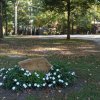Prime Hook National Wildlife Refuge staff could get an earful during a series of public hearings on its updated 1,200-page comprehensive conservation plan.
The two legislators who serve the area have already gone on record saying they don't agree with the plan's preferred alternative to deal with flooding, beach erosion and marsh degradation problems plaguing the refuge. Required by federal law, the plan will guide all aspects of managing the 10,100-acre refuge over the next 15 years.
Sen. Gary Simpson, R-Milford, and Rep. Harvey Kenton, R-Milford, say they stand behind most area residents who want the beach and freshwater marshes restored.
The federal plan offers three alternatives: Option A would maintain status quo, continuing current management practices; Option B – the preferred alternative – would manage the refuge to mimic natural processes by restoring all four impoundments to salt marsh, doing away with freshwater marsh; and Option C would return the refuge to the way it was managed early in the last decade by maintaining artificial freshwater impoundments behind a restored dune line along Delaware Bay.
Since 2009, several breaches in the dune line have allowed the free flow of saltwater into refuge marshes. Saltwater has caused extensive damage to the Unit 2 freshwater impoundment, and that damage is extending into Unit 3. Refuge officials have to put off any work until after the conservation plan is adopted.
“Most area residents would find anything but the last option unacceptable,” Simpson said. “I am a little disturbed that federal officials seem to give great weight to projections of sea-level rise as if these predictions are fully substantiated. In fact, they are, at best, speculative. What we know for a fact is that we have residents who need our help now, and we should do what we can to protect them instead of resigning ourselves to a fate that is not set in stone.”
Kenton said the U.S. Fish and Wildlife Service has a mission to manage its refuges for the benefit of wildlife, with all other considerations being secondary, including the welfare of local residents. “I see things differently. I believe government has an obligation to protect the homes, property and livelihoods of its citizens. It is my hope that against all odds, the feds will ultimately select Option C.”
Kenton said farmers in the area have lost 110 acres due to saltwater intrusion. He added that saltwater is also threatening to contaminate freshwater wells for local homeowners and crops.
Public hearings on plan upcoming
U.S. Fish and Wildlife Service has scheduled six hearings to solicit public comments.
The formal public hearing is from 6-9 p.m. Tuesday, June 19, at Cape Henlopen High School, 1250 Kings Highway, Lewes, with other meetings geared toward specific topics.
Those hearings are as follows:
6-9 p.m. Thursday, June 7, Milford Senior Center, hunting.
1-4 p.m. Saturday, June 9, Milton Fire Hall, 116 Front St., Milton, habitat management.
6-9 p.m. Tuesday, June 12, Cape Henlopen High School, hunting.
6-9 p.m. Thursday, June 11, Milton Fire Hall, wildlife observation and photography, fishing, environmental education and interpretation.
The refuge will also have open houses on three Sundays from 1-4 p.m. on June 10 and 17 to answer questions regarding the plan. The refuge is located on Turkle Pond Road east of Route 1 outside Milton.
Comments on the plan can be made at the hearings or by mail, fax and e-mail with a deadline of Monday, Aug. 6. Addresses and numbers are: northeastplanning@fws.gov; 413-253-8468; Thomas Bonetti, U.S. Fish and Wildlife Service, 300 Westgate Center Dr., Hadly, MA 01035.
Copies of the plan can be downloaded at fws.gov/northeast/primehook or ask for a copy on CD-ROM from refuge staff at 302-684-8419 or at the above email address.




















































